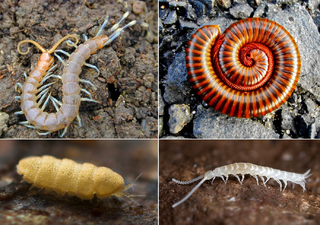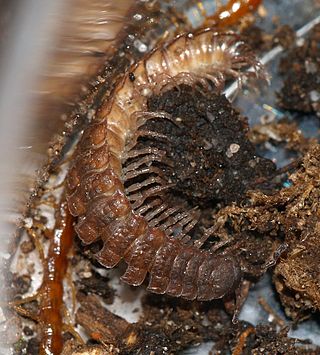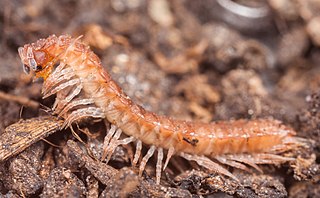
Myriapods are the members of subphylum Myriapoda, containing arthropods such as millipedes and centipedes. The group contains about 13,000 species, all of them terrestrial.

Pill millipedes are any members of two living orders of millipedes, often grouped together into a single superorder, Oniscomorpha. The name Oniscomorpha refers to the millipedes' resemblance to certain woodlice (Oniscidea), also called pillbugs or "roly-polies". However, millipedes and woodlice are not closely related ; rather, this is a case of convergent evolution.

Slapton Ley is a lake on the south coast of Devon, England, separated from Start Bay by a shingle beach, known as Slapton Sands.

Pneumodesmus newmani is a species of myriapod. It is originally considered that it lived during the late Wenlock epoch of the Silurian period around 428 million years ago. However, a 2017 study dates its occurrence based on zircon data analysis as the Early Devonian (Lochkovian). Although the 2023 study confirmed the age identification of the 2004 study through palynological, palaeobotanical and zircon analyses incorporating newly discovered additional data, this is based on adjacent structurally separated block with different stratigraphy and sedimentology to the block with fossil site it was discovered, and it is confirmed as unsustainable. It is one of the first myriapods, and among the oldest creatures to have lived on land. It was discovered in 2004, and is known from a single specimen from Stonehaven, Aberdeenshire, Scotland.

Tachypodoiulus niger, known variously as the white-legged snake millipede or the black millipede, is a European species of millipede. It is very similar to other species such as Cylindroiulus londinensis, from which it can be reliably distinguished only by studying the shape of the telson. It occurs in Ireland, Britain, Spain, France, Benelux, Germany, Switzerland, Austria and the Czech Republic, and is especially common on chalky and limestone soils.

Glomerida is an order of pill-millipedes found primarily in the Northern Hemisphere. Also known as northern pill millipedes, they superficially resemble pill-bugs or woodlice, and can enroll into a protective ball. They have twelve body segments, 17 to 19 pairs of legs, and males have enlarged rear legs involved in mating. The order includes about 30 genera and at least 280 species, including Glomeris marginata, the common European pill-millipede. The order contains members in Europe, South-east Asia and the Americas from California to Guatemala. Although historically considered closely related with the similar sphaerotheriidans that also enroll, some DNA evidence suggest they may be more closely related to glomeridesmidans, a poorly known order that does not enroll.

Woodlice are terrestrial isopods in the suborder Oniscidea. Their name is derived from being often found in old wood, and from louse, a parasitic insect, although woodlice are neither parasitic nor insects.

Polydesmus angustus, also known as the flat-backed millipede, is a millipede in the genus Polydesmus native to Western Europe.

Polyxenidae is a family of millipedes in the order Polyxenida containing approximately 47 species in 19 genera. All adults in this family have 13 pairs of legs.

Glomeridesmida is an order of millipedes in the infraclass Pentazonia containing two families and at least 35 described species. Glomeridesmida is the only living order of the superorder Limacomorpha. Glomeridesmidans are also known as slug millipedes.

Archipolypoda is an extinct group of millipedes known from fossils in Europe and North America and containing the earliest known land animals. The Archipolypoda was erected by Scudder (1882) but redefined in 2005 with the description of several new species from Scotland. Distinguishing characteristics include relatively large eyes with densely packed ocelli, and modified leg pairs on the 8th body ring. Some species had prominent spines while others had a flattened appearance.

Chordeumatida is a large order of millipedes containing more than 1,400 species. Also known as sausage millipedes, they are found nearly worldwide. Chordeumatida is the largest order in the superorder Nematophora, a group also known as spinning millipedes because their telsons feature spinnerets used to build nests of silk. These millipedes produce this silk to create chambers in which to molt or to lay their eggs.

Casimir Albrecht Willem Jeekel (1922–2010) was a Dutch myriapodologist and entomologist known for his major contributions to the taxonomy of millipedes. His 1971 monograph Nomenclator Generum et Familiarum Diplopodorum is credited as launching the "modern era" of millipede taxonomy, and has been considered the "most important single work ever published on the Diplopoda". He served as director of the Zoological Museum Amsterdam, and authored over 150 works on the taxonomy of millipedes and other myriapods.

Glomeris connexa is a species of pill millipede within the genus Glomeris and family Glomeridae.
Glomeridesmidae is a millipede family of the order Glomeridesmida. This family includes two genera: The genus Glomeridesmus includes most species in this family; the genus Glomeridesmoides includes one species.

Cleidogonidae is a family of millipedes in the order Chordeumatida. Adult millipedes in this family have 28, 29, or 30 segments. This family includes the genus Tianella, notable for featuring adult millipedes with 29 segments, a number not found in the adults of any other chordeumatidan species. Adults in most Tianella species have 29 segments, but adults in two have only 28 segments. In the Tianella species with 29 segments, adult females have 48 pairs of legs, as one would expect in adult female chordeumatidans with one segment fewer than the 30 usually found in this order. There are seven genera and at least 140 described species in Cleidogonidae.

Craspedosomatidae is a family of millipedes in the order Chordeumatida. Most adult millipedes in this family have 30 segments, but some have only 28. There are at least 30 genera and 210 described species in Craspedosomatidae.
Geophilus osquidatum is a species of soil centipede in the family Geophilidae found in western Europe, from mainland Spain through western France to Britain and Ireland, though it's also been recorded in Italy, Czech Republic, and Germany. Males of this species have 51 to 57 pairs of legs; females have 53 to 63 leg pairs. This species grows up to 30 millimeters and is bright yellow with a darker reddish head. Because of this, it's often confused with G. flavus and G. gracilis. Its subspecies, G. osquidatum porosum, was found synonymous with G. flavus. In Britain, G. osquidatum is found in a wide range of habitats including woodland, grassland, and coastal shingle as well as gardens and waste ground.

Brachydesmus superus, sometimes called the flat millipede, is a species of millipede in the family Polydesmidae. Its specific name is from the Latin word for "above, upper," because it lives in the upper soil layer.

















